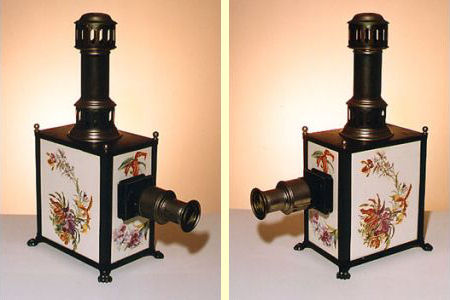|
|
Ceramic magic lanterns. |
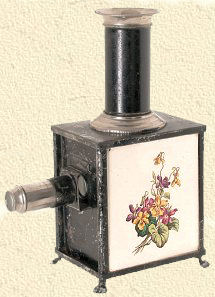 Perhaps the term 'ceramic' is a little bit misleading, as these magic lanterns are not entirely made of a ceramic material. Like similar magic lanterns, they are largely made of metal and some glass elements. They differ from similar magic lanterns in the body, whose walls consist of porcelain or earthenware tiles or, in other cases, are entirely made of ceramic. The tiles are almost always decorated with colourful floral ornaments, sometimes with playing children. The ornaments are transfer prints (decals) under glaze. After the blank tile is formed and fired, a transfer print is applied. After removing the oil that was present in the decal a final glaze is applied and after the final firing the decal has become an integral part of the tile. Only a few manufacturers have made ceramic lanterns, The German toy manufacturers Johann Falk and Max Dannhorn are probably the only ones. The lamp houses made by Falk all have ceramic panels (tiles) in a metal frame; the lamp house of the lantern that Dannhorn made has a spherical shape. However, as we can learn from the following it is even questionable if those manufacturers are the real makers of these ceramic lanterns. Because these lanterns were very vulnerable, they are very scarce nowadays and therefore much sought after by collectors who are willing to pay high prices for them. |
|
|
The square model, attributed to
Johann Falk. First variant. |
||
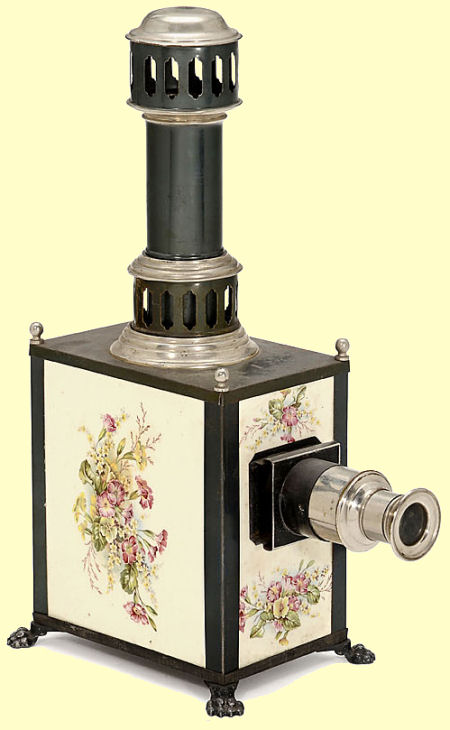 |
There are three
variants of the square model. The first variant is provided with three tiles
which have embossed marks on the inside. Mostly two numbers indicate the
size of the panel in cm, varying from 12 x 11 cm to 21 x 17 cm. Sometimes an
additional embossed mark can be found that is possibly a mark of the ceramic
factory. The magic lanterns have usually embossed marks in the metal door on
the back of the lantern. They show either simply 'D.R.G.M',
that stands for 'Deutsche Reichs Gebrauchs Muster', a German patent, or
'LUNA D.R.G.M. No. 192 102 PATENTED in U.S.A.'. The period of protection was
limited to three years. Eye-catching are the four
metal knobs in the corners of the roof.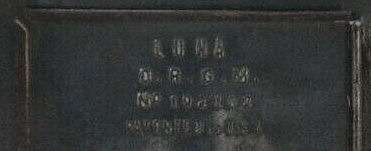 Model Luna, 1895. Beautiful German magic lantern with 'Keramikfliesen' (ceramic tiles) on three sides that are decorated with a nice floral design. It has claw feet and nickel plated parts on its metal frame body and the lens. The access door on the back of the lantern has the initials "D. R. G. M." embossed into the metal. The lantern was on sale in several sizes and with various flower designs. This one measures 12.5 x 9 x 22 cm. |
|
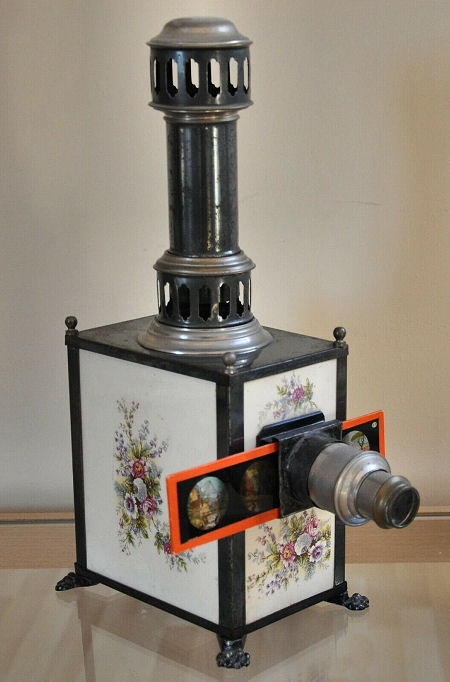 |
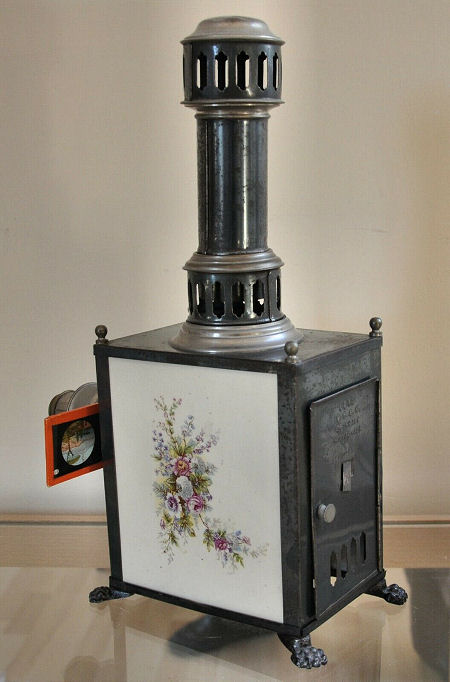 |
|
|
The same model with another
decoration...... Photos: ©Pierre Patau, antiquetoysandgames.com.
|
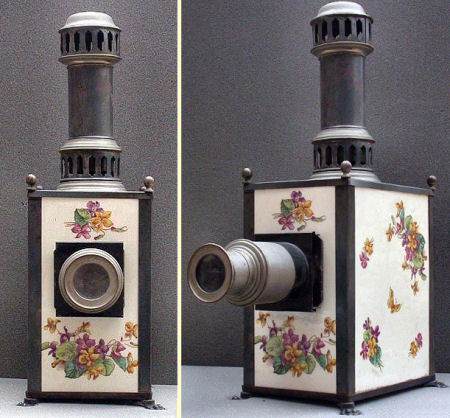 |
|
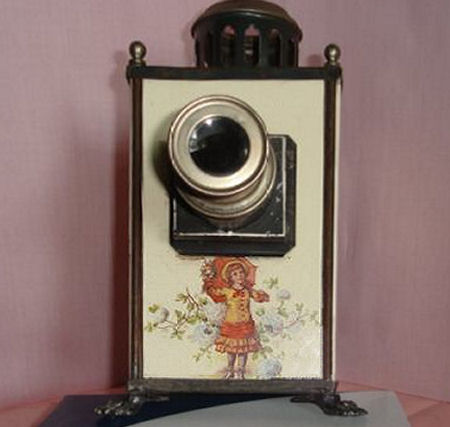 |
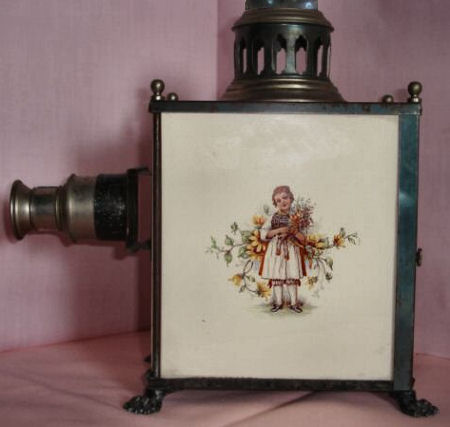 |
|
|
This time the tiles are not decorated with flowers but
by images of a young girl. |
||
|
Second variant.
The second variant has only two ceramic side panels. The front and back are made of plain metal. Like the lanterns of the first variant they have small claw feet. Again the tiles have embossed numbers that indicate the size, varying from 12 x 11 cm to 20 x 16. They usually have the embossed mark 'D.R.G.M.' in the back door. The overall implementation is much simpler than that of the first variant. The roof lacks the four knobs and the chimney is little more than a straight tube. |
||
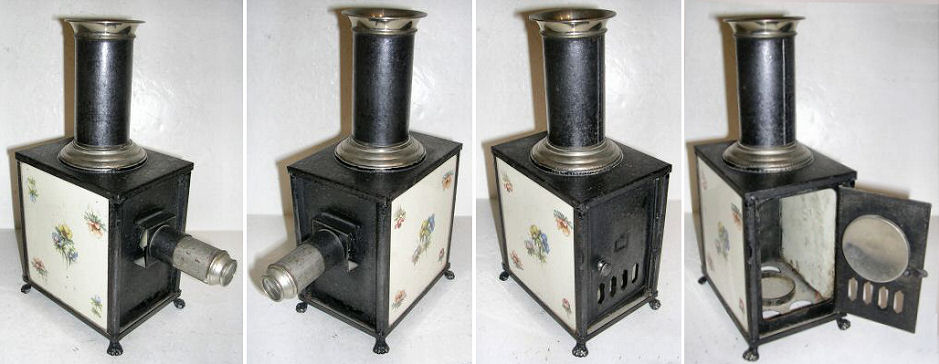 |
||
|
Third variant.
Like the first variant this variant has three ceramic panels, but there are remarkable differences. The roof is curved, the chimney is angled and the feet are triangular and made of cast metal. A metal part underneath the hole in the bottom can hold the burner. The embossed mark is mostly placed in the backdoor, but sometimes there is a metal plate soldered underneath the bottom. |
||
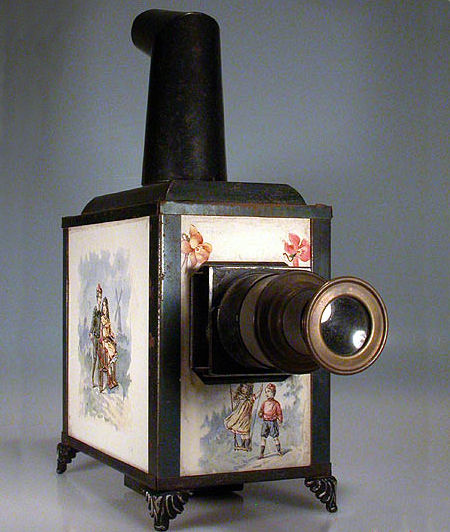 |
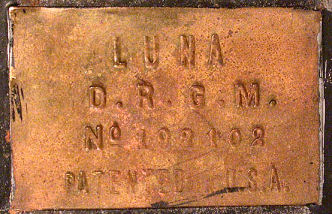 Metal lantern on folded triangle feet. Framed in front and sides are glazed ceramic panels decorated with decals showing children at play. A plate underneath the lantern reads "LUNA D.R.G.M No 192102 PATENTED USA". DRGM points to a German patent (Deutsche Reichs Gebrauchs Muster). Probably the lantern was made in Germany (by Johann Falk?), especially for the American market. The lantern is about 10 5/8" x 9 1/4" x 3 3/4" (27 x 23.5 x 9.5 cm). Photos: ©Pierre Patau, antiquetoysandgames.com. |
|
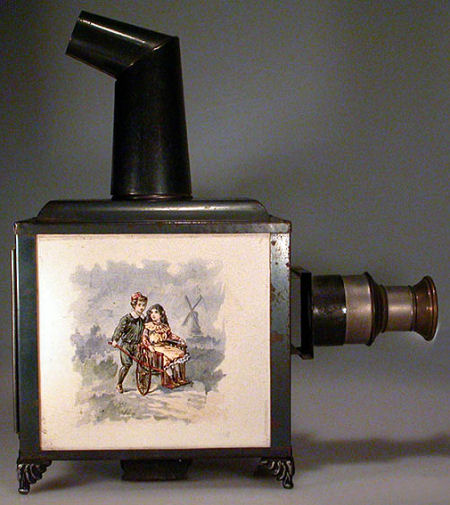 |
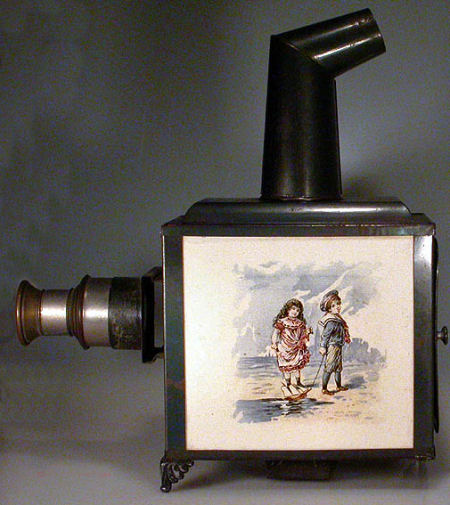 |
|
|
Are these square magic
lanterns really made by Johann Falk?
The magic lanterns above have no labels of a manufacturer. According to an investigation of Helmut Wälde is the owner of the D.R.G.M. No 192102 patent for a 'Zauberlanternegehäuse mit verzierter Wandung aus keramischem Material' the German David Benda, Fürth. Some of the square lanterns are additional marked 'Patented in U.S.A. This patent was registered to Simon Hamburger of New York, assigned to the company of Hamburger & Co. of New York. |
||
| The spherical model, made by Max Dannhorn. | ||
|
The spherical models seem to be even more rare than the
square models from Falk. Thought there seem to be some variants they do not
differ much from each other. The known lanterns have a total height of about
30 cm and the wooden base is about 11 x 18 cm. The diameter of the ceramic
body is about 10 cm. All ceramic bodies known are decorated with floral
ornaments. Some square and round models are executed with an identical
decal. This suggests that the ceramic parts for the round and square
lanterns were manufactured by the same ceramic company. The ceramic lanterns are rare because the are fragile. The ceramic body had to be removed from the burner twice, when the light was lit and when it was put out, for there was no door in a wall. For easily fixing the body on the burner a metal ring is cemented to the underside of it. After using the lantern many times this ring could become loose and this increased the risk of the body falling and breaking. |
||
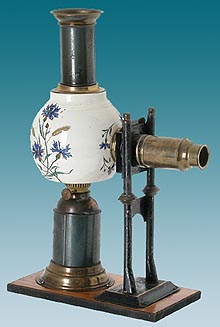 |
Max Dannhorn, 1890. Splendid lantern with spherical ceramic hand painted and glazed lamp house. Oil reservoir and lens support on wooden base. Straight chimney with brass flanges. Produced with several flower decorations. This lantern is breakable and therefore only seldom found nowadays. Height: 11" (28 cm); diameter lamp house 4" (10 cm). |
|
|
Are these spherical magic
lanterns really made by Max Dannhorn? There is no evidence for this assumption. All we have is the D.R.G.M. for the firm David Benda, Fürth, and the U.S.A. patents for Simon Hamburger which almost certainly also include the spherical lantern. It is likely that the firms David Benda and Hamburger & Co. had a business partnership relating to ceramic magic lanterns. Due to the fact that the ceramic lanterns were protected by the D.R.G.M. for the firm David Benda, this firm should, according to investigator Helmut Wälde, be considered the maker of all the ceramic magic lanterns mentioned above. But who ever thought that Falk and Dannhorn are the manufacturers ?! |
||
|
|
||
| |
©1997-2021 'de Luikerwaal' All rights reserved. Last update: 16-05-2021. |
